Calendars in Conflict
Published in Early Modern History (1500–1700), Features, Issue 2 (Summer 2002), Volume 10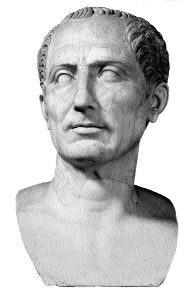
Julius Caesar inaugurated the ‘old’ calendar in 45 BC.
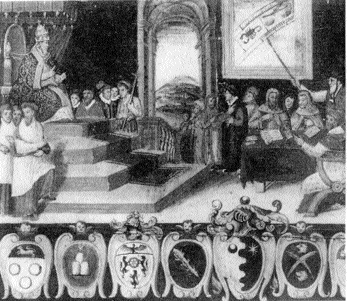
Gregory XIII, seen meeting with his calender commission c.1581, inaugurated the ‘new’ one in March 1582.
This year the town of Kinsale chose to commemorate the four-hundredth anniversary of its famous battle according to the new style system of dating. The Irish and the Spaniards fought the battle on 3 January 1602 according to the new calendar laid down by Pope Gregory XIII nineteen years previously, whereas the English fought the engagement on 24 December 1601 in accordance with the old calendar which they and other Protestants continued to use. It is Fr John Silke’s definitive 1970 account, based on archival research in Spain, which is primarily responsible for this preference for 3 January as the appropriate anniversary.
Same battle on different dates
This clash of calendars raises a neglected question about the battle of Kinsale. Did the difference in year and day affect the psychology of the two armies fighting the same battle on different dates? The trapped English army was yet to have its Christmas dinner and indeed was unlikely to have any if it did not win. On the other hand, the Irish had already celebrated Christmas and New Year—maybe these celebrations made them over-confident.
One thing that Lughaidh Ó Cléirigh notes in his account of the battle in his Beatha Aodha Ruaidh Uí Dhomhnaill [Life of Red Hugh O’Donnell] is that the Irish, for the first time in their long campaign, had serious internal arguments when O’Neill and O’Donnell disagreed over tactics and precedence. Ó Cléirigh’s account should not be accepted uncritically, however, since it was written perhaps twenty years after the battle. No contemporary account mentions internal dissension in the Irish camp. Ó Cleirigh’s dissension story is more than likely a literary motif that explained why God had doomed the Irish! We will never know whether the difference in dates had a bearing on the battle of Kinsale but it does provide an opportunity to examine the general impact of the Gregorian calendar in Ireland.
Discrepancy in Julius Caesar’s ‘old calendar’
The old calendar, inaugurated in 45 BC by Julius Caesar, had 365 days and with a leap year every fourth year. It had calculated the year at 365 days and six hours but the actual length of a year is 365 days, five hours, forty-eight minutes, forty-six seconds. Over the years this discrepancy caused a slippage of days. In the Middle Ages various proposals were made to reform the calendar, in particular because Easter was getting later and later in the year. Nothing happened until the issue was brought up again at the great Counter-Reformation Council of Trent. The proposed publication of a new breviary for the Catholic church in the final session of 1562-3 was the green light for a papal commission on calendar reform set up in the 1570s under the chairmanship of the German Jesuit astronomer Christopher Clavius (1538-1612). This commission worked on a set of proposals originally made by an Italian physician Aloysius Lilius (1510-76). The commission, calculating the year at 365 days, five hours, forty-eight minutes and twenty seconds, proposed dropping ten days in a single year and omitting one leap year in every four hundred in order to realign the calendar. They proposed a more accurate method of establishing the date of Easter. They also proposed that the New Year should universally begin on 1 January rather than on Lady Day, the feast of the Annunciation, 25 March.

German Jesuit astronomer Christopher Clavius (1538-1612), chairman of Gregory’s calender commission. (Mary Evans Picture Library)
Pope Gregory after a period of consultation and deliberation published the commission’s proposals in the Papal Bull Inter Gravissimas in March 1582. It proposed that the new style calendar should be inaugurated by dropping ten days at the start of October because that month had the least number of important church feasts. This change-over required the co-operation of the civil authorities to be effected. There was full co-operation in Italy, Spain, Portugal and Poland so that people going to bed on 4 October woke up on the 15th. France followed suit in December and some Catholic districts of Germany and the Netherlands even missed Christmas in making the change-over!
Shades of the current Euro debate
It was a different matter with the Protestant states of Europe. They were disinclined to accept the logic of the calendar change because it gave the appearance of acting at the behest of the pope of Rome. They therefore dug in their heels and stuck to the old Julian Calendar rather than accept the pope’s authority. In England there were shades of the current Euro debate. Queen Elizabeth and her government were in favour of the change; advised by the astronomer John Dee they planned in the course of 1583 to drop three days in May, one in June and three each in July and August. However approval was not forthcoming from Edmund Grindal, the puritan Archbishop of Canterbury. He said that cosying up to Rome in this way would put England in schism with the other Protestant churches. Furthermore the Church of England could not accept an edict from a papacy that ‘all the reformed churches in Europe for the most part do hold and affirm is Antichrist’. When a bill for calendar reform was tabled for the 1584 parliament, it had to be quietly dropped. Presumably the growing tide of anti-popery made it impossible to proceed with the kingdom under threat from foreign invasion.
The English authorities in Dublin, without a parallel development in England, were not in favour of adopting the pope’s new calendar in Ireland. However that did not necessarily stop the process. One must assume that the Catholic Church would have pushed the change—this after all was an age when the church and its agents were still the primary keepers of time—and there were Catholic lords ruling parts of Ireland where the writ of the queen of England did not run. On the face of it the change should be clearly observable. The days of the week in each calendar still ran in tandem—Sunday was still Sunday—but under the new Gregorian calendar Catholics would now have had their Holy days ten days before Protestants and in many cases the date of Easter and the moveable feasts dependent upon it also changed.
In 1583 Easter in both calendars actually occurred on the same day. Subtracting ten days from the new style date takes us back to the old style date on 31 March—there are a finite number of Sundays on which Easter could occur! The following year the new style Easter happened four weeks earlier than the old style one. In a letter dated 26 March 1584 old style the government in Dublin reported to London that Hugh O’Neill, Baron of Dungannon, was at Strabane with his old adversary Turlough Luineach O’Neill ‘solemnizing their new Easter of the Pope his appointing’. The old style Easter was still three weeks away. Dublin was alarmed at this diplomatic activity which saw not only the hitherto loyal Baron of Dungannon sinking his differences with the ageing Turlough Luineach but also both men making in effect a joint religious declaration. The lords justices in Dublin reported themselves as being ‘mere strangers’ to these goings-on in the North.
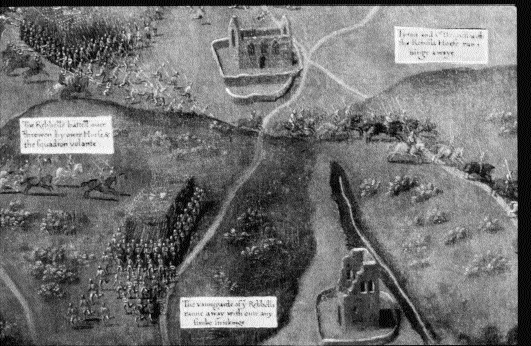
Detail from a map of the battle of Kinsale. Did the difference in year and day affect the psychology of the two armies fighting the same battle on different dates? (Reproduced by permission of the Board of Trinity College, Dublin)
Was this Easter celebration undertaken by the two main Gaelic lords of the North in 1584 of religious significance or was it a mere political gesture? We have no more evidence until 1590. When at the start of the year Hugh O’Neill executed his rival for power Hugh Gavelach MacShane O’Neill, it was reported that Gavelach had been captured by Maguire’s bastard son ‘on Christmas Eve last by the new computation’. Furthermore later in 1590 Miler Magrath, the Church of Ireland archbishop of Cashel, reported on the state of the Popish church in Ireland to the authorities in London. Miler was well-placed to do so hailing as he did from Ulster and having originally been the Catholic bishop of Down. He stated that the Catholic church in Ulster was still a going concern under the leadership of Redmond O’Gallagher, bishop of Derry and custos Armaghensis:
Being one of the three Irish bishops that were in the Council of Trent, this bishop used all manner of spiritual jurisdiction thoughout all Ulster, consecrating churches, ordaining priests, confirming children and giving all manner of dispensations, riding in pomp and company from place to place, as it was accustomed in Queen Mary’s days, and for the rest of the clergy there they use all manner of service now as in that time and not only that but they have changed the time, according to the Pope’s new invention.

Italian physician Aloysius Lilius (1510-76)-the calender commission worked on a set of proposals originally made by him. (Biblioteca Nazionale di Napoli)
However in Munster where Magrath also discussed the state of institutional Catholicism he made no mention of a similar calendar change. It is also notable that The Annals of Loch Cé composed in Roscommon up to 1590 used the old calendar. It may be that the calendar change was only adopted in the province of Armagh and not elsewhere because only there was there enough church organisation to hold synod and enough open political support.
Confessionalisation
If the Catholic church in Ireland adopted the new calendar nationwide, it may have had a significant impact. Surely the Counter-Reformation clerics would have sought to introduce the change in the other ecclesiastical provinces as heat was turned up in the course of the 1590s. The calendar change had a bearing throughout Europe in what historians refer to as ‘confessionalisation’. The changes in date as regards feast days had a clear impact in separating Protestants from Catholics. In the small German states, neighbouring regions which differed in their choice of religion were after 1582 suddenly celebrating Easter, Christmas and other significant dates in the Christian calendar at different times. In the Czech lands there was considerable confusion because the large Protestant minority refused to accept the new calendar. The interesting aspect in Ireland is that in the early 1580s many Irish, especially those in the towns had still not made up their minds about religion. Most were still attending the services of the state church which controlled their ancestral places of worship as church papists. In their decision to become recusants there were push and pull factors. There was political disenchantment with government policies towards the Old English, the descendants of the original Anglo-Norman conquerors, and there was also the growing alternative attraction of young missionaries drawn in many instances from their own community returning from continental seminaries imbued with the fervour of the Counter-Reformation. Might the calendar change have been also an additional factor here. Since the Church of Ireland was now not celebrating the major Christian feasts on the same date as Catholics, the so-called church papists and those priests who were also church papists would surely then have had to make a choice.
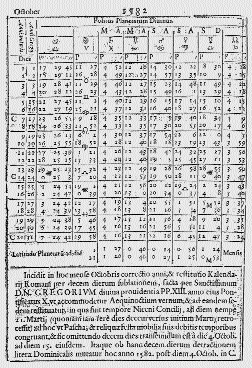
Page from an astronomical calender for October 1582. Note how the vertical column second from the left (‘Anni Grego’) jumps from ‘4′ to ‘15′.
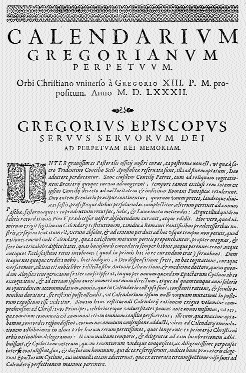
Opening page of Gregory XIII’s papal bull Inter Gravissimas, March 1582.
Most Irish townsmen defected from the state church in the late 1580s and especially the early 1590s. William Lyons, the Protestant archbishop of Cork, writing in 1596, blamed the agitation attending the beginning of the outbreak of the Nine Years War:
within these two years so far, that where I had a thousand or more in a church at sermon, I now have not five; and whereas I have seen 500 communicants or more, now are there not three; and not one woman either at Divine service or communion.
‘Ten seminary and seducing priests’, as he called them, were living openly and working freely in Cork city supported by the aldermen and merchants of the town.
Nine Years War
During the Nine Years War, O’Neill, O’Donnell and their confederates employed the new calendar. In the spring and early summer of 1596 the crown intercepted letters dated new style to O’Neill from his secretary Henry Hovenden. These were important intercepts. The first is a letter of advice to O’Neill on the pros and cons of making peace with England and the second written after the intervention of Spanish agents reveals the deliberate delaying tactics the confederates were using in negotiations with the state. Writing from O’Donnell’s camp in Connacht, Hovenden began: ‘All the delays that could possibly be used for prolonging the causes here have not been omitted’. Soon the crown was inserting into the periodic ceasefire arrangements that it was having to make with the confederates phrases indicating that these agreements were being made by the Anglican computation in case the Irish would take advantage of their dating system to go on the offensive ten days early! The Earl of Essex’s six week ceasefire with O’Neill after the famous meeting at the ford of Bealnaclinthe is titled ‘Articles agreed upon for a cessation of arms between the lord lieutenant of Ireland and the earl of Tirone on the 8th of September 1599 in the old stile’.
O’Neill also had become daring enough to write to the crown using the pope’s calendar—for instance one endorsed ‘copy of the earl of Tyrone’s letter dated the 7 of December 1597 but received from him in November 1597’. O’Neill also dated his famous proclamation to the Palesmen in November 1599 by the Gregorian calendar. This ends:
I seeking the publick utility of my native country and means for your salvation will prosecute these wars until that generally Religion be planted throughout all Ireland, so I rest praying the almighty to move your flinted hearts to prefer the commodity and profit of our country before your private ease.
Dungannon, this fifteenth of November 1599.
This appeal to the Palesmen on the grounds of common religion and nationality fell on deaf ears. Nevertheless we do know it was dated new style. Thomas Barnwell of Robertstown, County Meath, acquired a copy on 8 November old style and made a declaration to that effect to the Dublin government on 15 November old style. It might be argued that the confederate usage of the new calendar was mere gesture politics, an exercise in contrariness. However it did serve to identify their cause with the pope’s and to underscore their demand for the free exercise of Catholicism.

Table
Did the use of the new calendar in Ireland survive the defeat at Kinsale and the collapse of the confederate cause? The institutional strength of the Catholic church in Ulster was severely undermined by the plantation and throughout the country Catholics were subject to ferocious episodes of persecution. Yet Counter-Reformation Catholicism strengthened in this harsh environment. If Irish adherents of Catholicism were really in communion with Rome, surely they must have adhered to the same feast dates as the pope. After all the Gregorian calendar feast dates were available printed in the missals and breviaries of the church. However the Catholic church in Ireland was—under instruction from Rome—trying to be as non-political as possible and indeed may have also been told to stick to the calendar of the state. In fact there is little evidence to indicate the use of the new calendar in the seventeenth and early eighteenth centuries. The entries in Friar O’Mellan’s journal, which recorded the rising in Ulster between 1641 and 1647, are in the old style. However my UCC colleague K.W. Nicholls has come across wills which must have been dated new style. The testators’ deaths were recorded by the state as occurring on a date before that which the deceased, presumably Catholics attended by their priests, had signed and dated the will. This is the sort of evidence we would need on a large scale. Interestingly neither the Catholic Confederation of Kilkenny in the 1640s or the Catholic-dominated Patriot Parliament in James II’s time attempted to introduce the new calendar. These movements were however far less separatist than the Irish Confederates of the 1590s.
The British state eventually adopted the new calendar in 1752. Fearing falling a further day behind—that is eleven days—most Protestant states in continental Europe had adopted the new calendar in 1700. England eventually fell into line in 1752. This time the bill in the 1750-51 Westminster parliament was passed with little rancour. It enacted the change ‘in and throughout all his Majesty’s dominions and countries in Europe, Asia, Africa and America, belonging or subject to the crown of Great Britain’. There was no need for a separate enactment of the Irish parliament. By default this solved the problem of the calendar as a distinction, if it existed, between Protestants and Catholics in Ireland. This was how the Orange Order, founded subsequently in 1795, came to celebrate another famous battle—the Boyne, fought on 1 July 1690 old style—on the 12th by a system of dating originally decreed by ‘that man of the sin’, the pope of Rome.
Hiram Morgan lectures in history at University College Cork.
Further reading:
G.V. Coyne, M.A. Hoskin & O. Pedersen, Gregorian Reform of the Calendar (Vatican 1983).
D. Ewing Duncan, The Calendar (London 1998).
J.J. Silke, Kinsale: Spanish intervention in Ireland at the end of the Elizabethan wars (Liverpool 1970, reprint Dublin 2001).
C. Dillon, ‘Cín Lae Uí Mheall’ in Friar Ó Mellan’s Journal’, Dúiche Néill, x, (1995-6).
















